Doug Wilcox
(Royal School of Science, 1965-68)
Doug shares his memories of falling in love with a 'demanding, wicked painted lady'.
Ashley Brown (Computing 2007) gives an update on Jezebel today.
I came to Imperial College London keen to study Physics but immediately fell in love, like so many innocents before me, with ‘Jezebel’ - a demanding, wicked painted lady, thirty-three years my senior. Falling under her spell, I was soon inducted into the happy cabal of her admiring acolytes; becoming just one more of her toy-boys (and the odd toy-girl) who pandered to this old lady’s every whim. Forty years on (and newly pensioned off) I find that some of her awesome vital statistics seem to still vividly hang in my memory (but must surely have been apocryphal?) Could this Goddess’s capacity for inhalation really have been 14 litres? Her tappet clearances ¼ of an inch? Her appetite for fuel one gallon per token spin up Kensington Gore? The feisty old girl must be 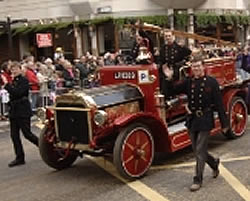 pushing 95 by now, almost spanning this Imperial Centenary herself, but I believe she’s still going strong since I saw her fleetingly on TV in the last Lord Mayor of London’s parade. Generations of students must have continued to fall under her spell since my day - lay-attendants all of us serving at her greasy altar.
pushing 95 by now, almost spanning this Imperial Centenary herself, but I believe she’s still going strong since I saw her fleetingly on TV in the last Lord Mayor of London’s parade. Generations of students must have continued to fall under her spell since my day - lay-attendants all of us serving at her greasy altar.
For the uninitiated ‘Jezebel’ is, of course, the veteran mascot of the Royal College of Science (RCS). She was born in 1916, a very early petrol-driven Dennis fire-engine. Later, when her days were numbered, the Dennis company who spawned her kindly donated the old lady to the College. Between lectures and practicals, evenings and week ends, thousands of man/ woman hours were lavished on her upkeep and renovation. And since my time at Imperial many more hours must have continued to be lavished, year upon year, upon her brass-work, her enormous engine, her solid-rubber tyres and quirky braking system (consisting of a leather belt loosely wrapped around her prop-shaft which tightens when the brake lever is heaved back by the force of several crew members). I have a fond memory of sacrificing my own trouser belt to running repairs on the way back from Jez’s London-to-Brighton Vintage Commercial Vehicle Run when, with an awful smell of burning, Jez‘s own belt gave up the ghost! (Surely Health and Safety Officers haven’t yet insulted her by insisting on the installation of ABS four-wheel braking?) Without the continuing love and attention of all her student attendants the old girl would surely have expired years ago. (Photo above by Paul Lobbock: Lord Mayors Show 2006)
In my graduate days the motor club was fortunate to include post-grad Paul Ward who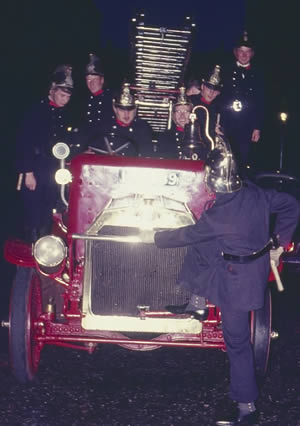 had contacts with veteran fire-engine enthusiasts in the North West and managed to cadge several original brass helmets and pairs of leather boots. Girlfriends ran up authentic uniforms, based on Paul’s collection of early 20th century fire-brigade photos. ‘Jez’ and her period crew became such a stunning, ghostly sight on the streets of Kensington that we were actually waved down in Exhibition Road one day by a film director driving a ‘mini-moke’ (who overtook and swerved in front of us police-style, clearly having no intelligence of the fragility of Jez’s braking system!) He was a film director talent-spotting for authentic images of London’s swinging 60’s and there-and-then signed up Jez and her crew to appear in a feature film called ‘The Joker’. We received a contract for a very welcome few hundred quid, paid to the Motor Club and some months later commandeered a local cinema’s back row stalls, in fireman’s uniform, to cheer on Jez’s fleeting screen appearances. (Photo above: 'The full Monty!' From right to left: Paul Ward (later to become a top-notch technician at Kodak); another club member; Derwyn Evans, The motor Club's welsh contingent, at the wheel; Tony Smart, co-driver and emergency fire-bell ringer beside him; to the rear right a ghostly trio of long departed 1914 fire crew, appearing ectoplasmically here on the emulsion of this photograph in jealous honour of their still-living feisty red queen; and, finally, foreground right, yours truly, Doug Wilcox, risking life and manhood, standing on the starting handle and waiting for the driver's call of 'ignition' upon which word to launch his whole weight in a supreme effort of crank rotation which, one time in ten, might result, almost magically, in a roar and a cloud of exhaust smoke.)
had contacts with veteran fire-engine enthusiasts in the North West and managed to cadge several original brass helmets and pairs of leather boots. Girlfriends ran up authentic uniforms, based on Paul’s collection of early 20th century fire-brigade photos. ‘Jez’ and her period crew became such a stunning, ghostly sight on the streets of Kensington that we were actually waved down in Exhibition Road one day by a film director driving a ‘mini-moke’ (who overtook and swerved in front of us police-style, clearly having no intelligence of the fragility of Jez’s braking system!) He was a film director talent-spotting for authentic images of London’s swinging 60’s and there-and-then signed up Jez and her crew to appear in a feature film called ‘The Joker’. We received a contract for a very welcome few hundred quid, paid to the Motor Club and some months later commandeered a local cinema’s back row stalls, in fireman’s uniform, to cheer on Jez’s fleeting screen appearances. (Photo above: 'The full Monty!' From right to left: Paul Ward (later to become a top-notch technician at Kodak); another club member; Derwyn Evans, The motor Club's welsh contingent, at the wheel; Tony Smart, co-driver and emergency fire-bell ringer beside him; to the rear right a ghostly trio of long departed 1914 fire crew, appearing ectoplasmically here on the emulsion of this photograph in jealous honour of their still-living feisty red queen; and, finally, foreground right, yours truly, Doug Wilcox, risking life and manhood, standing on the starting handle and waiting for the driver's call of 'ignition' upon which word to launch his whole weight in a supreme effort of crank rotation which, one time in ten, might result, almost magically, in a roar and a cloud of exhaust smoke.)
Thereafter an extended range of RCS motor club events blossomed alongside Jez‘s full-time care programme: in conjunction with Engineering students we manufactured a racing car to be entered in a twenty-four hour race (no, not at Le-Mans but at Bristol University, during their Rag week). The specification for entry was that propulsive output be limited to one manpower - Oh, alright! These were sophisticated high-tech kiddie pedal cars but the drama was definitely ‘le-mans’; with headlights blazing for non-stop lapping through the night and rolling pit stops where one knackered driver/pedaller could roll out of the car onto a pit-side mattress whilst the next, fresh driver jumped in.
The first of these events was held on a ‘Monaco’ style circuit around the streets of Bristol but, no doubt following police advice, once the top speeds of these lightweight cars (propelled by the finest athletes our colleges could muster) had been demonstrated.  In subsequent years the race was staged at a nearby disused airfield. Vivienne Thickitt (now my wife) who was studying physiology at UC, brought along a team of fellow students to monitor our racing peddlers’ well-being by sampling their heart rates, blood pressures, oxygenation and urine at every driver change throughout the 24 hours. I believe her UC tutors were rather more impressed by their report on this enterprising physiology research than Imperials were with the Motor Club’s laudable series of class wins and film appearances! (Photo above: Preparation of RCS Hillclimb car - RCS Motor club members - Doug Wilcox left, Steve.....? right (how can I forget a mate's name, even 40 years on? This photo was taken in the yard behind Chemistry, the location of Jezebel's garage. The hill-climb competition car was built from scratch here.)
In subsequent years the race was staged at a nearby disused airfield. Vivienne Thickitt (now my wife) who was studying physiology at UC, brought along a team of fellow students to monitor our racing peddlers’ well-being by sampling their heart rates, blood pressures, oxygenation and urine at every driver change throughout the 24 hours. I believe her UC tutors were rather more impressed by their report on this enterprising physiology research than Imperials were with the Motor Club’s laudable series of class wins and film appearances! (Photo above: Preparation of RCS Hillclimb car - RCS Motor club members - Doug Wilcox left, Steve.....? right (how can I forget a mate's name, even 40 years on? This photo was taken in the yard behind Chemistry, the location of Jezebel's garage. The hill-climb competition car was built from scratch here.)
Encouraged by our successes, though, the motor club built a hill-climb trials car to compete in formula ‘Austin 7’ events and I enrolled for driver training in a formula-three racing school at Brand’s Hatch’s ‘Motor Racing Stables’ where I visited at week-ends - whenever I could afford the fees (we lived on meagre grants in those days, not on accumulating debts!) Tony Lanfranchi was top driver / trainer and soon got me lapping the club circuit in respectable race times.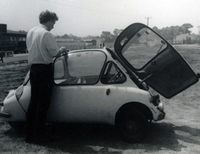 I managed to bring a little comic relief to these sessions as my only affordable transport down the A3 to Brands Hatch was an elderly Heinkel Bubble Car - which I’d bought from a British Telecom ‘sandwich’ student, Ralph Cornforth, for £15! (On graduation I sold it on, in turn, to a fresher for £20!) It had a one cylinder, 200cc engine and a top speed of about 28mph - quite a contrast to the circuit’s race cars! Other trainee drivers, who tended to arrive at Brand’s Hatch in their (parents'?) Jags and Lotus’s, would cheer me into the pit area on arrival. (Latterly, they cheered even louder since I had to clamber out of the bubble car’s canvas sun-roof (the single door at the front having been rendered no longer serviceable following problems with rusty hinges, hastily remedied by welding the door permanently in place! (Were there MOT’s in those days - surely not!) (Photo above: Doug Wilcox arrives at Brands Hatch by bubble car (pre-loss of door function!) for training session with Tony Lanfranchi in formula three race-car: quite a contrast in performance from trundling up the A3 in the bubble to screaming round the club circuit at Brands!)
I managed to bring a little comic relief to these sessions as my only affordable transport down the A3 to Brands Hatch was an elderly Heinkel Bubble Car - which I’d bought from a British Telecom ‘sandwich’ student, Ralph Cornforth, for £15! (On graduation I sold it on, in turn, to a fresher for £20!) It had a one cylinder, 200cc engine and a top speed of about 28mph - quite a contrast to the circuit’s race cars! Other trainee drivers, who tended to arrive at Brand’s Hatch in their (parents'?) Jags and Lotus’s, would cheer me into the pit area on arrival. (Latterly, they cheered even louder since I had to clamber out of the bubble car’s canvas sun-roof (the single door at the front having been rendered no longer serviceable following problems with rusty hinges, hastily remedied by welding the door permanently in place! (Were there MOT’s in those days - surely not!) (Photo above: Doug Wilcox arrives at Brands Hatch by bubble car (pre-loss of door function!) for training session with Tony Lanfranchi in formula three race-car: quite a contrast in performance from trundling up the A3 in the bubble to screaming round the club circuit at Brands!)
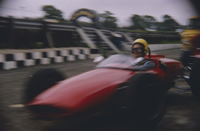 I only discovered that I wasn’t cut out to be a racing driver, following these weekend jaunts when Tony L, in acknowledgement of my good lap times, entered me in a student ‘race’: OK, on a clear track I could post quickish lap times but when it came to overtaking and ‘mixing it’ with other competing drivers - which seemed to me extremely dangerous - I found myself content to let them pass. I discovered that I valued my bodily well-being far too much to be a racer. I’d seen too many top drivers like ‘Jim Clarke’ die in the sport. In hindsight I realise it was my interest in the science and engineering of car design, all along, which had attracted me to motor sport - rather than any desire to win podium places (I don’t recall the winners even wasting Champagne in those halcyon days?) (Photo above: Doug Wilcox accelerating out of pit lane)
I only discovered that I wasn’t cut out to be a racing driver, following these weekend jaunts when Tony L, in acknowledgement of my good lap times, entered me in a student ‘race’: OK, on a clear track I could post quickish lap times but when it came to overtaking and ‘mixing it’ with other competing drivers - which seemed to me extremely dangerous - I found myself content to let them pass. I discovered that I valued my bodily well-being far too much to be a racer. I’d seen too many top drivers like ‘Jim Clarke’ die in the sport. In hindsight I realise it was my interest in the science and engineering of car design, all along, which had attracted me to motor sport - rather than any desire to win podium places (I don’t recall the winners even wasting Champagne in those halcyon days?) (Photo above: Doug Wilcox accelerating out of pit lane)
The motor club swansong of my days at Imperial took me back to Brands Hatch, where 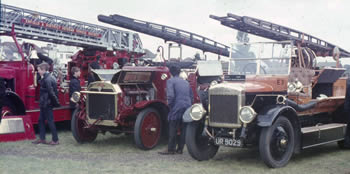 the RCS motor club was invited in 1968, to take part in a ‘Mini festival’ to celebrate the tremendous success of designer Alec Issigonis’s pioneering of the first (and most famous) front wheel drive technology. It was a lovely day (and, as it happened, the day before my first ‘finals’ exam back in Kensington!). Alec Issigonis was a lovely, as well as a talented, man - to be seen around the circuit well inebriated and intent on shaking the hand of everyone present. (Photo above: Jez 'strutting her stuff' for the spectators at one of the many Vintage Fire Engine rallies run by enthusiasts the world over. We often took Jezebel out, over the years, to meet her contemporaries and she always rose to the occasion. I seem to recall the interior of Jez's garage festooned with rosettes, certificates of merit and few spare parts. Is it still thus? I note that Jez's near-side brass headlamp is missing in the photo. I'm pretty sure no one stole it - although the bloke alongside in the blue coat and hush-puppies does look rather shifty... we only ever had the two original lamps! Perhaps one was out of shot having a final polish from fanatical motor club members and their girlfriends before the judges with their clip-boards came round. Note also the enormous bulk of Jez's engine, beneath the open bonnet flaps, which almost annually needed to be stripped down and fitted with new crank bearings or cylinder head valves (we were so keen that gangs of us would often be there at the garage in the summer vacations, working overtime.) The Dennis factory and other enthusiasts contributed enormously to Jez's welfare, conjuring up rare, spare parts without cost to us.)
the RCS motor club was invited in 1968, to take part in a ‘Mini festival’ to celebrate the tremendous success of designer Alec Issigonis’s pioneering of the first (and most famous) front wheel drive technology. It was a lovely day (and, as it happened, the day before my first ‘finals’ exam back in Kensington!). Alec Issigonis was a lovely, as well as a talented, man - to be seen around the circuit well inebriated and intent on shaking the hand of everyone present. (Photo above: Jez 'strutting her stuff' for the spectators at one of the many Vintage Fire Engine rallies run by enthusiasts the world over. We often took Jezebel out, over the years, to meet her contemporaries and she always rose to the occasion. I seem to recall the interior of Jez's garage festooned with rosettes, certificates of merit and few spare parts. Is it still thus? I note that Jez's near-side brass headlamp is missing in the photo. I'm pretty sure no one stole it - although the bloke alongside in the blue coat and hush-puppies does look rather shifty... we only ever had the two original lamps! Perhaps one was out of shot having a final polish from fanatical motor club members and their girlfriends before the judges with their clip-boards came round. Note also the enormous bulk of Jez's engine, beneath the open bonnet flaps, which almost annually needed to be stripped down and fitted with new crank bearings or cylinder head valves (we were so keen that gangs of us would often be there at the garage in the summer vacations, working overtime.) The Dennis factory and other enthusiasts contributed enormously to Jez's welfare, conjuring up rare, spare parts without cost to us.)
Our RCS highlight was an attempt on the ‘most-in-a-mini’ challenge - sponsored, we understood, by the McWhirter brothers: the brief was to install as many human beings as possible into a standard Mini car and drive it 50 yards. No protruding body parts were allowed to hang out of windows. We were allowed to fit a tiny (one pint) replacement fuel tank for safety reasons. As we’d been provided with a copy of the rules in advance, the motor club had been able for some weeks beforehand to visit every lady’s college and nurses home in London to recruit the most petit young ladies we could ‘pull’.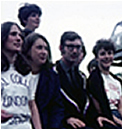 They were totally unaware of their fate, of course, since we hunted in pairs: Tony Smart would sidle up close to slim girls at parties with a discrete chalk mark on his jacket sleeve at a height of exactly four-feet-nine-inches and I would assess from across the room those who might qualify as passengers - whom we would then chat up and proposition. The Motor Club hired a coach to take the daintiest 25 recruits - with the lure of a great party afterwards - down to Brands Hatch for the day. It was such a major Motor Club event that, for the first time ever, RCS College President ‘George’ came along in full regalia (and took the opportunity to regale several of the young ladies we’d rounded up for our challenge attempt!) (Photo above: His honour 'George', 1968 Royal College of Science President - glorifying by his esteemed and dignified presence RCS Motor Club's juvenile attempt to cram the most human beings possible into a mini car and drive it 50 yards)
They were totally unaware of their fate, of course, since we hunted in pairs: Tony Smart would sidle up close to slim girls at parties with a discrete chalk mark on his jacket sleeve at a height of exactly four-feet-nine-inches and I would assess from across the room those who might qualify as passengers - whom we would then chat up and proposition. The Motor Club hired a coach to take the daintiest 25 recruits - with the lure of a great party afterwards - down to Brands Hatch for the day. It was such a major Motor Club event that, for the first time ever, RCS College President ‘George’ came along in full regalia (and took the opportunity to regale several of the young ladies we’d rounded up for our challenge attempt!) (Photo above: His honour 'George', 1968 Royal College of Science President - glorifying by his esteemed and dignified presence RCS Motor Club's juvenile attempt to cram the most human beings possible into a mini car and drive it 50 yards)
We’d hatched a cunning plan of military precision: One girl’s left foot operated the clutch,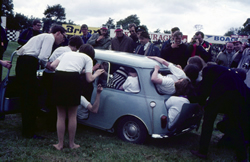 of which she had no sight since many others were piled on top her to roof height. Another had a hand on the steering wheel but with no sight of the road through the flesh-choked windscreen; another the gear shift, which when slipped into first, on the order to ‘go, go, go’, initiated a chorus of communal screams by fellow passengers enduring, knock-on limb displacements. Just one diminutive male club member (who shall remain nameless) bravely volunteered to be shoehorned under the rear seat - where all the ladies had drawn the line. With four in the boot (God knows how in retrospect!), me shouting instructions through a megaphone at point-blank range, the car’s suspension hopelessly bottomed (fortunately BMC had provided these minis, not expecting them to be returned in showroom condition!) we managed to stagger our fifty yards to the chequered flag with eighteen people on board! As I recall, all the girls and, to his embarrassment, the one gent got another hug and kiss from
of which she had no sight since many others were piled on top her to roof height. Another had a hand on the steering wheel but with no sight of the road through the flesh-choked windscreen; another the gear shift, which when slipped into first, on the order to ‘go, go, go’, initiated a chorus of communal screams by fellow passengers enduring, knock-on limb displacements. Just one diminutive male club member (who shall remain nameless) bravely volunteered to be shoehorned under the rear seat - where all the ladies had drawn the line. With four in the boot (God knows how in retrospect!), me shouting instructions through a megaphone at point-blank range, the car’s suspension hopelessly bottomed (fortunately BMC had provided these minis, not expecting them to be returned in showroom condition!) we managed to stagger our fifty yards to the chequered flag with eighteen people on board! As I recall, all the girls and, to his embarrassment, the one gent got another hug and kiss from 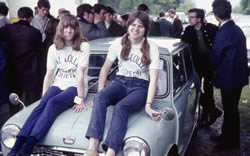 Sir Alex Issigonis. Of course, we won the competition hands down (arms up, knees dislocated, necks twisted, erogenous zones (allegedly) goosed and many intimate relationships forged!) That single male passenger, who’s name I cannot now recall, is probably still to this day, boasting about just how many girls he’s had in the back seat of a mini! On the way home we stopped at a pub and treated the girls to a cracking good night out. Everyone got on like a house-on-fire (there was no ice left to break after an afternoon of such intimate physical proximity!) The bill for this evening was rather higher than the fee for our appearance in ‘The Jokers’! Wouldn’t it be just fabulous if some of those feisty girls, after all these years, turned up at the Centenary celebrations? (Photo above: two girls in differing stages of resigned terror as they await their fate, sitting on the very car (supplied by BMC) in which they and sixteen other friends are destined to drive the fifty yards to meet the challenge. Tony Smart and Brian Megginson look on, right, nervously whilst the crowd, having heard of our intentions, gather round in vacant disbelief.)
Sir Alex Issigonis. Of course, we won the competition hands down (arms up, knees dislocated, necks twisted, erogenous zones (allegedly) goosed and many intimate relationships forged!) That single male passenger, who’s name I cannot now recall, is probably still to this day, boasting about just how many girls he’s had in the back seat of a mini! On the way home we stopped at a pub and treated the girls to a cracking good night out. Everyone got on like a house-on-fire (there was no ice left to break after an afternoon of such intimate physical proximity!) The bill for this evening was rather higher than the fee for our appearance in ‘The Jokers’! Wouldn’t it be just fabulous if some of those feisty girls, after all these years, turned up at the Centenary celebrations? (Photo above: two girls in differing stages of resigned terror as they await their fate, sitting on the very car (supplied by BMC) in which they and sixteen other friends are destined to drive the fifty yards to meet the challenge. Tony Smart and Brian Megginson look on, right, nervously whilst the crowd, having heard of our intentions, gather round in vacant disbelief.)
To our annoyance the subsequently published ‘Guinness book of records’ entry showed, and still shows, eighteen passengers as the world record - but credits its achievement to a later date and a Midland’s venue. Apparently, our first ‘most in a mini’ world record made at Brands Hatch - and never since surpassed - was disallowed entry into the famous Book on dubious administrative grounds which were never explained to us. We, to this day, believe ‘we woz robbed’!
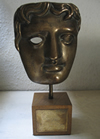 After graduation I worked at Rolls-Royce’s Aero Division at Derby where in the training workshop Sir Henry Royce’s original lathe was displayed on a raised dais bestrewn with gold link chains like an altar. (People had pride and admiration for British engineering back then.) When Rolls overstretched itself on the RB211 engine and went spectacularly bust in 1971, I avoided redundancy by moving back to London to work in BBC engineering, (eventually managing to scale the impenetrable wall built by the BBC in those days between engineering and program staff) to become a Programme Director; later going freelance as a producer/director and receiving a BAFTA award for my work in 1982. For a little while I felt a shade guilty for ‘wasting’ such a fine education in physics - but was soon reassured by experience that a good education can equip one for a plethora of alternative careers.
After graduation I worked at Rolls-Royce’s Aero Division at Derby where in the training workshop Sir Henry Royce’s original lathe was displayed on a raised dais bestrewn with gold link chains like an altar. (People had pride and admiration for British engineering back then.) When Rolls overstretched itself on the RB211 engine and went spectacularly bust in 1971, I avoided redundancy by moving back to London to work in BBC engineering, (eventually managing to scale the impenetrable wall built by the BBC in those days between engineering and program staff) to become a Programme Director; later going freelance as a producer/director and receiving a BAFTA award for my work in 1982. For a little while I felt a shade guilty for ‘wasting’ such a fine education in physics - but was soon reassured by experience that a good education can equip one for a plethora of alternative careers.
With the exception of my tutors (especially the wonderful father figure who astonished all hundred and fifty of us freshers on day-one by knowing all our names and backgrounds off pat ) most of the friendships I fondly recall were forged in the garage rather than in the library (where ‘brown-baggers’ were to be seen most evenings and weekends striving to swot up on the daily avalanche of newly-discovered fundamental particles.) The mystery of our clairvoyant first year tutor - whose name, ironically has, all these years on, slipped my mind - was solved when we discovered in his tutorial room a display of passport photos and notes on each one of us pasted up on the wall; he’d clearly been absorbing all the sordid low-down on us during the hols before our arrival!
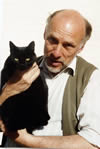 I plan to attend various centenary events in 2007 and would especially love to meet up with Jez’s past, present and future ‘minders’. The Beit Quad Barbeque might be a good venue - on Sunday 16 September 2007 (Beit was our home base for most of these 1960’s Motor Club exploits.) (Photo: Doug Wilcox with Smut the cat)
I plan to attend various centenary events in 2007 and would especially love to meet up with Jez’s past, present and future ‘minders’. The Beit Quad Barbeque might be a good venue - on Sunday 16 September 2007 (Beit was our home base for most of these 1960’s Motor Club exploits.) (Photo: Doug Wilcox with Smut the cat)
For further information regarding the reunion click here or email; reunions@imperial.ac.uk
Ashley Brown, part of the Motor Club that currently look after Jez, responds to Doug's memory on 22 May 2007:
Jez and her current crew would be delighted to meet Doug at the Beit Quad Barbeque, we're still in touch with a variety of people from the past 50 years and hope a selection of them will attend. As a Jez toy-boy of four years I can confirm that Jez is indeed still going strong, except when she decides she wants a rest of course. Many hours of research over the past decade mean we also know a lot more about the history of Jez than ever before.
Doug's recollection of her thirst for petrol sounds about right, although she has been known to pour an entire tank over the floor for her own amusement. Her capacity for inhalation is, however, just a shade over 9 litres and not 14. The days of leaping on the starting handle are gone; we can reliably start Jez with just a tickle and a few half-turns on the starting handle, leaving the ignition off until everything is well clear to avoid being thrown across the carriageway. Unless, of course, she decides she doesn't feel like going anywhere today, thank you very much.
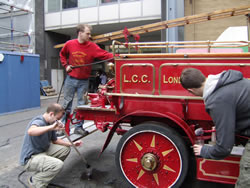 Much time and effort is still expended greasing, washing and polishing Jez and she often brings in the odd prize or two. She has a number of siblings as competition, which lead a far more leisurely lifetyle: travelling 1,000 miles a year is not uncommon for Jez. The accompanying photograph shows a number of current members giving her a scrub on 5th May 2007, before embarking on the annual run to Brighton (Photo right: left to right, Peter Mountney, Ashley Brown, David Noonan). Doug will also see a surprising addition, there's a pump attached to the back. The original one from 1916 was chopped off between 1932 and 1955 when Jez was at Joseph Crosfield & Son in Warrington (she arrived at the College in 1955 when she was retired from there, and served with the London Fire Bridgade before that from 1916-1932). Students attached a pump from 1926 in the late 70s and Jez is now able to pump with the best of them at fire shows.
Much time and effort is still expended greasing, washing and polishing Jez and she often brings in the odd prize or two. She has a number of siblings as competition, which lead a far more leisurely lifetyle: travelling 1,000 miles a year is not uncommon for Jez. The accompanying photograph shows a number of current members giving her a scrub on 5th May 2007, before embarking on the annual run to Brighton (Photo right: left to right, Peter Mountney, Ashley Brown, David Noonan). Doug will also see a surprising addition, there's a pump attached to the back. The original one from 1916 was chopped off between 1932 and 1955 when Jez was at Joseph Crosfield & Son in Warrington (she arrived at the College in 1955 when she was retired from there, and served with the London Fire Bridgade before that from 1916-1932). Students attached a pump from 1926 in the late 70s and Jez is now able to pump with the best of them at fire shows.
Tales of Jez's antics can be found at http://www.union.ic.ac.uk/rcc/rcsmotor/history/brief/, with a comprehensive photo gallery available at http://www.union.ic.ac.uk/rcc/rcsmotor/gallery/.
We look forward to meeting anyone with fond (or even not so fond!) memories of Jez at Centenary events this year:
Jez will be at the Centenary Ball on Saturday 16 June
Alumni Reunion on Saturday 15 September
Commemoration Day on Wednesday 24 October
If you would like regular updates about Jez, please email rcsmc@imperial.ac.uk and ask to be added to the email mailing list.
© 2007 Imperial College London
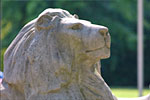
Through the first decade of the twenty-first century the campaign seeks to philanthropically raise £207 million from Imperial’s alumni, staff and friends, and donations from charitable foundations and industry.
Where your support can make a differenceGive now

Imperial’s Centenary Year provides an opportunity to recognise and celebrate members of the Imperial community.
View staff and student portraits
